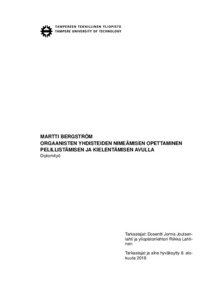Orgaanisten yhdisteiden nimeämisen opettaminen pelillistämisen ja kielentämisen avulla
Bergström, Martti (2018)
Bergström, Martti
2018
Teknis-luonnontieteellinen
Teknis-luonnontieteellinen tiedekunta - Faculty of Natural Sciences
This publication is copyrighted. You may download, display and print it for Your own personal use. Commercial use is prohibited.
Hyväksymispäivämäärä
2018-12-05
Julkaisun pysyvä osoite on
https://urn.fi/URN:NBN:fi:tty-201811222717
https://urn.fi/URN:NBN:fi:tty-201811222717
Tiivistelmä
There are many different names, markings and conventions in chemistry that need to be memorized in order to achieve deeper learning and understanding of the subject. However, memorizing is an ineffective way of learning and oftentimes an uninteresting method for the pupil. Learning is also made more challenging in chemistry because of the three levels of knowledge one has to move between of, micro level, macro level and symbolic level. These have been proved out to be problematic especially in the secondary school during which the interest of the pupils towards the subject should be built up.
Gamification has been previously studied and used in diversification of teaching and making the pupils more interested in otherwise dull activities. Languaging on the other hand has been studied especially in mathematics as a way of expressing the thought process of a pupil and how it affects learning. Previous studies show that through verbal or written expression a pupil has to parse information again and in a better way than previously which leads to deeper learning and understanding of the subject.
This study was conducted as a design based research in which the objective was to create a complete set of exercises for teaching nomenclature of organic compounds using the means of gamification and to study how the pupils can be motivated via gamification. Another point of interest was examining how the integration of the concepts of languaging in teaching nomenclature of organic compounds could help the learning process of the pupils. Based on the analysis of the situation, a complete set of exercises for teaching nomenclature of organic compounds using the means of gamification and concepts of languaging has been created and after the first research cycle a number of improvements have been presented. Analysis of the results indicate that the pupils experienced the means of gamification and languaging mainly positively although the learning results were varied. Kemian oppimiseen liittyy paljon erilaisia nimiä, merkintöjä ja sääntöjä, joiden ulkoa opettelu on välttämätöntä syvällisemmän ymmärryksen saavuttamiseksi. Asioiden ulkoa opettelu on kuitenkin tehoton ja oppilaan kannalta mielenkiinnoton menetelmä. Kemiassa oppimisen haasteena ovat myös kemiallisen tiedon kolme eri tasoa, mikrotaso, makrotaso ja symbolinen taso, joiden välillä opetuksessa ja oppimisessa liikutaan. Kemian opetuksen kannalta tämä on koettu ongelmalliseksi etenkin peruskoulun yläluokilla, jossa oppilaiden mielenkiintoa oppiainetta kohtaan pitäisi rakentaa.
Pelillistämistä on aiemmin tutkittu ja hyödynnetty opetuksen monipuolistamisessa ja oppilaiden mielenkiinnon kasvattamisessa muutoin tylsiä tehtäviä kohtaan. Kielentämisen menetelmiä hyödyntäen puolestaan on tutkittu matematiikassa oppilaan ajatusprosessin ilmaisemisen ja oppimisen välistä yhteyttä. Näissä tutkimuksissa on havaittu, että suullisen tai kirjallisen ilmaisun yhteydessä oppilas joutuu jäsentelemään tietoaan aiempaa paremmin, jolloin myös oppimistulokset ja asian ymmärrys kehittyvät.
Tämän tutkimuksen tarkoituksena oli selvittää, miten pelillistämisen hyödyntämisen avulla voidaan motivoida oppilasta orgaanisten yhdisteiden nimeämisen ulkoa opettelussa. Lisäksi tavoitteena oli tutkia, miten kielentämismenetelmien integrointi kemian opetukseen voisi auttaa oppilaita orgaanisten yhdisteiden nimeämissääntöjen opettelussa. Tutkimus on toteutettu kehittämistutkimuksena. Tilanneanalyysin perusteella tuotettiin pelillistämisen ja kielentämisen menetelmiä hyödyntävä opetuskokonaisuus orgaanisten yhdisteiden
nimeämisen opettamiseen ja ensimmäisen kehittämissyklin havaintojen pohjalta siihen on pohdittu parannusehdotuksia seuraavalle kehittämissyklille. Tutkimuksen perusteella oppilaat kokivat pelillistämisen ja kielentämisen menetelmät pääsääntöisesti positiivisesti, mutta niiden vaikutukset oppimistuloksiin olivat vaihtelevia.
Gamification has been previously studied and used in diversification of teaching and making the pupils more interested in otherwise dull activities. Languaging on the other hand has been studied especially in mathematics as a way of expressing the thought process of a pupil and how it affects learning. Previous studies show that through verbal or written expression a pupil has to parse information again and in a better way than previously which leads to deeper learning and understanding of the subject.
This study was conducted as a design based research in which the objective was to create a complete set of exercises for teaching nomenclature of organic compounds using the means of gamification and to study how the pupils can be motivated via gamification. Another point of interest was examining how the integration of the concepts of languaging in teaching nomenclature of organic compounds could help the learning process of the pupils. Based on the analysis of the situation, a complete set of exercises for teaching nomenclature of organic compounds using the means of gamification and concepts of languaging has been created and after the first research cycle a number of improvements have been presented. Analysis of the results indicate that the pupils experienced the means of gamification and languaging mainly positively although the learning results were varied.
Pelillistämistä on aiemmin tutkittu ja hyödynnetty opetuksen monipuolistamisessa ja oppilaiden mielenkiinnon kasvattamisessa muutoin tylsiä tehtäviä kohtaan. Kielentämisen menetelmiä hyödyntäen puolestaan on tutkittu matematiikassa oppilaan ajatusprosessin ilmaisemisen ja oppimisen välistä yhteyttä. Näissä tutkimuksissa on havaittu, että suullisen tai kirjallisen ilmaisun yhteydessä oppilas joutuu jäsentelemään tietoaan aiempaa paremmin, jolloin myös oppimistulokset ja asian ymmärrys kehittyvät.
Tämän tutkimuksen tarkoituksena oli selvittää, miten pelillistämisen hyödyntämisen avulla voidaan motivoida oppilasta orgaanisten yhdisteiden nimeämisen ulkoa opettelussa. Lisäksi tavoitteena oli tutkia, miten kielentämismenetelmien integrointi kemian opetukseen voisi auttaa oppilaita orgaanisten yhdisteiden nimeämissääntöjen opettelussa. Tutkimus on toteutettu kehittämistutkimuksena. Tilanneanalyysin perusteella tuotettiin pelillistämisen ja kielentämisen menetelmiä hyödyntävä opetuskokonaisuus orgaanisten yhdisteiden
nimeämisen opettamiseen ja ensimmäisen kehittämissyklin havaintojen pohjalta siihen on pohdittu parannusehdotuksia seuraavalle kehittämissyklille. Tutkimuksen perusteella oppilaat kokivat pelillistämisen ja kielentämisen menetelmät pääsääntöisesti positiivisesti, mutta niiden vaikutukset oppimistuloksiin olivat vaihtelevia.
